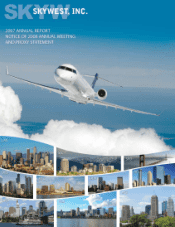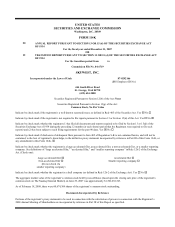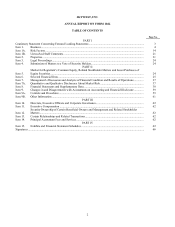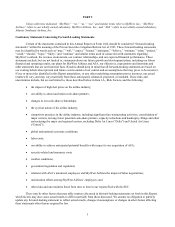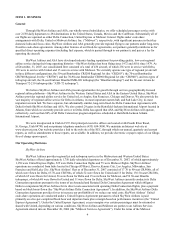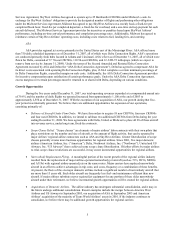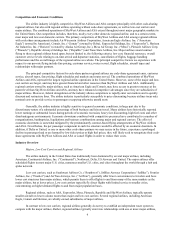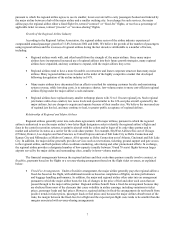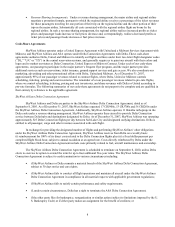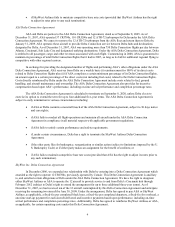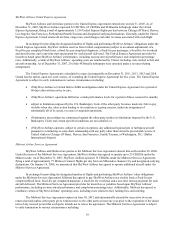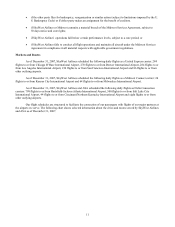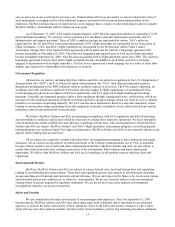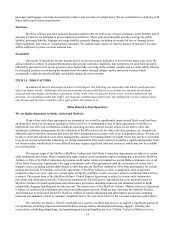SkyWest Airlines 2007 Annual Report Download - page 6
Download and view the complete annual report
Please find page 6 of the 2007 SkyWest Airlines annual report below. You can navigate through the pages in the report by either clicking on the pages listed below, or by using the keyword search tool below to find specific information within the annual report.5
Services Agreement, SkyWest Airlines has agreed to operate up to 25 Bombardier CRJ200s under Midwest’ s code. In
exchange for SkyWest Airlines’ obligation to provide the designated number of flights and performing other obligations
under the Midwest Services Agreement, Midwest has agreed to pay SkyWest Airlines on a weekly basis a fixed-fee per
completed block hour, fixed-fee per completed departure, a fixed-fee for overhead, and a one-time start-up payment for each
aircraft delivered. The Midwest Services Agreement provides for incentives or penalties based upon SkyWest Airlines’
performance, including on-time arrival performance and completion percentage rates. Additionally, Midwest has agreed to
reimburse certain of SkyWest Airlines’ operating costs, including costs related to fuel, landing fees, and catering.
ASA
ASA provides regional jet service primarily in the United States east of the Mississippi River. ASA offered more
than 750 daily scheduled departures as of December 31, 2007, all of which were Delta Connection flights. ASA’ s operations
are conducted primarily from hubs located in Atlanta and Cincinnati. ASA’ s fleet as of December 31, 2007, all of which were
flown for Delta, consisted of 37 70-seat CRJ700s, 110 50-seat CRJ200s, and 12 ATR-72 turboprops (which we expect to
remove from service by January 31, 2009). Under the terms of the Second Amended and Restated Delta Connection
Agreement executed by ASA and Delta (the “ASA Delta Connection Agreement”), Delta has agreed to compensate ASA for
its direct costs associated with operating Delta Connection flights, plus, if ASA completes a certain minimum percentage of
its Delta Connection flights, a specified margin on such costs. Additionally, the ASA Delta Connection Agreement provides
for incentive compensation upon satisfaction of certain performance goals. Under the ASA Delta Connection Agreement,
excess margins over certain percentages must be returned to or shared with Delta, depending on various conditions.
Growth Opportunities
During the five years ended December 31, 2007, our total operating revenues expanded at a compounded annual rate
of 39.6% and the number of daily flights we operated increased from approximately 1,100 at the end of 2003 to
approximately 2,550 as of December 31, 2007. With the exception of our acquisition of ASA, our growth during that five-
year period was internally generated. We believe there are additional opportunities for expansion of our operations,
consisting primarily of:
• Delivery of Aircraft Under Firm Order. We have firm orders to acquire 18 new CRJ700s, four new CRJ900s
and four used CRJ200s. In addition, we intend to sublease two additional CRJ700s from Delta during the year
ending December 31, 2008. We have agreements with Delta, United or Midwest to place all 28 of these aircraft
into revenue service, under long-term, fixed-fee contracts.
• Scope Clause Relief. “Scope clauses” are elements of major airlines’ labor contracts with their own pilots that
place restrictions on the number and size of aircraft, or the amount of flight activity, that can be operated by
major airlines’ regional airline contractors such as ASA and SkyWest Airlines. Greater liberalization of scope
clauses generally creates more business opportunities for regional airlines. Since 2001, five major domestic
airlines (American Airlines, Inc. (“American”), Delta, Northwest Airlines, Inc. (“Northwest”), United and US
Airways, Inc. “US Airways”) have achieved some scope clause liberalization. If further efforts by major airlines
to relax scope clause restrictions are successful, it may create incremental opportunities for regional airlines.
• Narrowbody Replacement Flying. A meaningful portion of the recent growth of the regional airline industry
resulted from the replacement of major airline-operated narrowbody jet aircraft (such as 737s, DC9s, MD80s
and A319s) with regional airline-operated jets on the same routes. Major carriers have replaced narrowbody
aircraft in an effort to achieve advantages in trip costs, unit costs, frequency or a combination of these benefits.
At present, the fleets of the six major domestic airlines include a significant number of narrowbody aircraft that
are more than 15 years old. Such older aircraft are frequently less fuel- and maintenance-efficient than new
aircraft. If major airlines substitute newer regional jet equipment for any portion of these older narrowbody
aircraft under their retirement, we believe incremental growth opportunities will be created for regional airlines.
• Acquisitions of Domestic Airlines. The airline industry has undergone substantial consolidation, and it may in
the future undergo additional consolidation. Recent examples include the merger between America West
Airlines and US Airways in September 2005, our acquisition of ASA in September 2005 and American
Airlines’ acquisition of the majority of Trans World Airlines’ assets in 2001. If the industry continues to
consolidate, we believe there may be additional growth opportunities for regional carriers.

